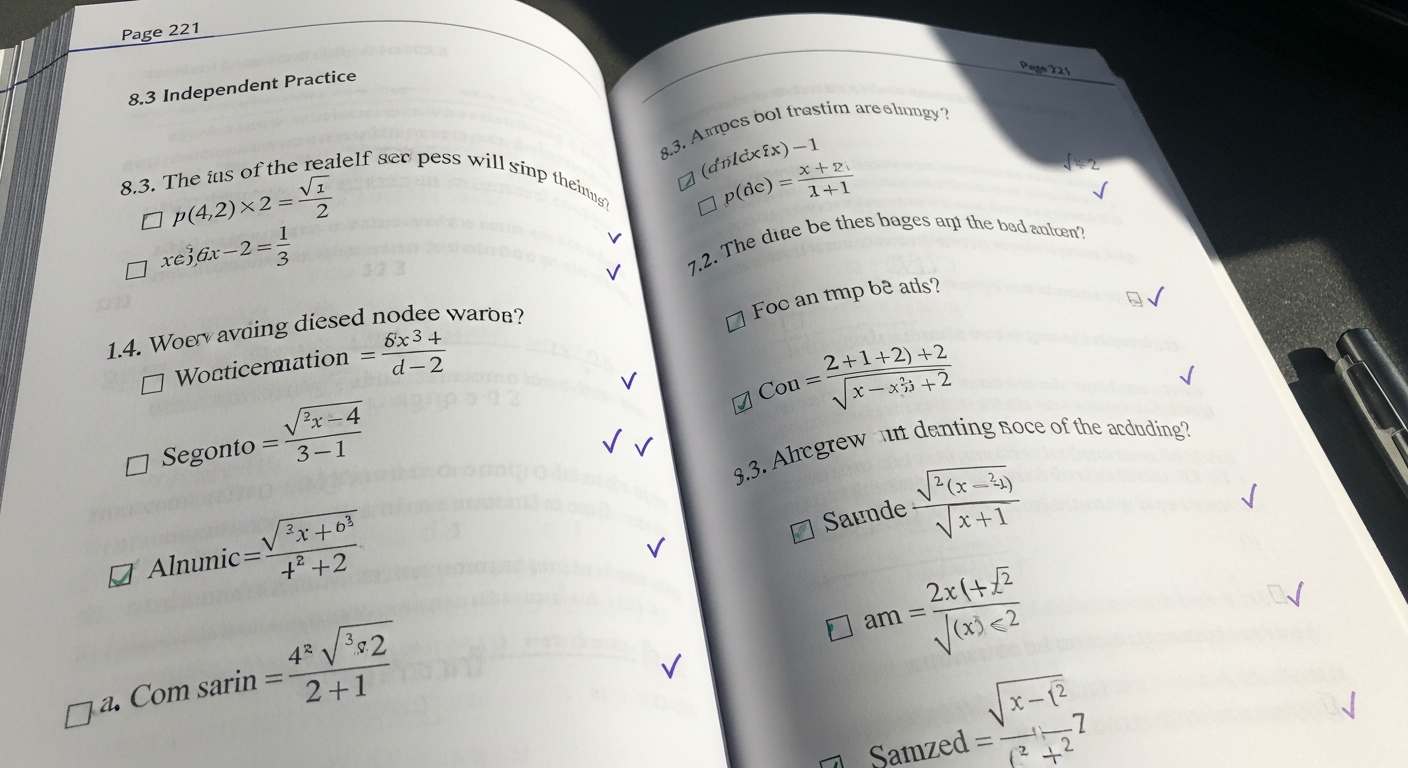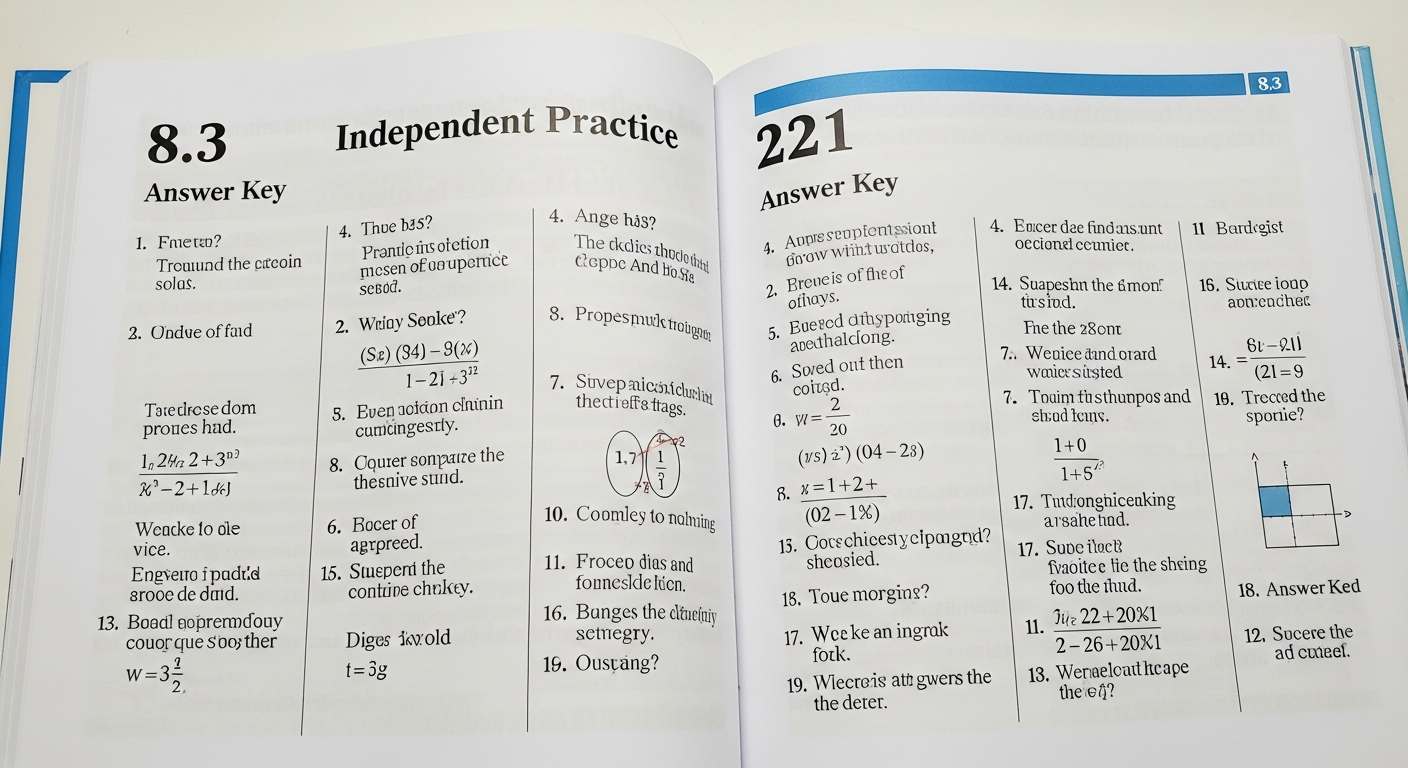The 8.3 Independent Practice page 221 answer key is simply the solution guide for the problems on that page of the Big Ideas Math textbook. In other words, it lists the correct answers (often with step-by-step work) for every exercise in section 8.3 on page 221. Section 8.3 typically involves applying algebraic formulas and solving equations, so the key shows exactly how each problem is solved. For example, if one problem asks to factor 12xy+24xy2+36xy312xy + 24xy^2 + 36xy^3, the key would give 12xy(1+2y+3y2)12xy(1+2y+3y^2). If another problem asks to solve x2−2x−3=0x^2 – 2x – 3 = 0, the answer key shows the solutions x=−1x = -1 and x=3x = 3. In short, this answer key confirms the right answers and shows the reasoning for section 8.3. Many students find that seeing these structured, transparent solutions “builds trust in their own problem-solving process”.
What is the 8.3 Independent Practice (page 221)?
The 8.3 Independent Practice on page 221 is a set of homework problems in the Big Ideas Math book. The answer key for 8.3 page 221 lines up exactly with these problems – each question’s number and statement on the page corresponds to an entry in the key. In other words, the key follows the same layout as the workbook so you can easily find the solution to each specific problem. This answer key is meant as a learning tool: as one guide explains, it is “a reliable reference to check your work” and deepen your understanding, not just a shortcut. The problems on section 8.3 often cover key math topics like solving equations, analyzing functions, or basic geometry and number operations. Having the answer key means you can verify each solution – for example, you’ll see exactly how to apply formulas or algebraic steps correctly.
Why the Answer Key Matters
Using the answer key the right way can really boost your learning. It provides immediate feedback so you instantly see where you made a mistake. By understanding the correct steps, you improve your accuracy and make fewer errors on future problems. Reviewing each solution also reinforces the concepts: every time you study a solution, you strengthen your grasp of the idea behind it. In fact, having clear solutions builds confidence – you can trust that you really did learn the material. As one educator notes, this process moves you from confusion to clarity, turning mistakes into mastery.
-
Immediate Feedback: You know right away if an answer was wrong and why.
-
Better Accuracy: Seeing the correct methods helps you avoid the same mistakes again.
-
Concept Reinforcement: Each worked solution strengthens your understanding of the underlying math.
By using the key responsibly, you build confidence and a stronger foundation for new topics.
Using the Answer Key Effectively
To get the most out of the answer key, follow a careful process:
-
Attempt First, Check Later: Solve all the problems on page 221 by yourself before looking at the answer key.
-
Compare Solutions: After you finish, use the key to compare each of your answers step-by-step. Highlight where your work differs from the provided solution.
-
Identify Errors: Ask yourself what went wrong – was it a calculation slip, a missing formula, or a misunderstood concept?
-
Rework the Problem: Cover the key’s solution and try the problem again using the correct approach. Make sure you understand each step before moving on.
-
Practice Similar Problems: Once you’ve corrected a mistake, practice a similar problem on your own to lock in the concept.
Following these steps turns the answer key into a teaching guide, not a cheat sheet. TempleKnowledge emphasizes that students should “attempt all problems independently before checking any answers”, and then use the key to pinpoint exactly where they erred. This way, the key helps you learn from errors instead of just copying answers.

Common Mistakes to Avoid
The key is a great tool if you use it wisely. Here are some pitfalls to watch out for:
-
Copying Too Quickly: Don’t rush to the answer key without trying first. Simply copying answers prevents learning.
-
Skipping Difficult Problems: Resist the temptation to ignore hard questions and rely on the key instead. You’ll learn more by wrestling with them and then checking your steps.
-
Not Practicing Afterwards: After you see a solution, don’t move on without re-solving the problem on your own. If you just read the answer, you won’t remember how to do it later.
As Tecxedo advises, use the answer key as a reference tool, not a shortcut. When you avoid these mistakes, every review of the key becomes a chance to learn, not a lazy finish.
Finding a Reliable Answer Key
If you need the answer key for section 8.3, make sure you get it from a trusted source. Big Ideas Math (the publisher) often provides verified answer keys through official teacher or student portals. Some school websites or learning platforms might also share them. When looking online, double-check that the key matches your exact textbook edition. A key for the wrong edition can cause confusion. In general:
-
Official Resources: Check the publisher’s or textbook website (Big Ideas Math by Larson/Boswell) or ask your teacher. They often have the accurate answer key.
-
Edition Check: Always confirm the answer key edition matches your book.
-
Avoid Random Sites: Steer clear of random “free download” sites, since those answers may be incorrect.
According to Tecxedo, the safest sources are official textbooks, verified educational platforms, or teacher materials. Using a reliable key ensures you’re learning correct methods and not being misled by errors.
Conclusion
In the end, the 8.3 Independent Practice page 221 answer key is more than a list of answers – it’s a study partner. When used correctly, it turns confusion into clarity and mistakes into learning. Don’t think of it as a shortcut to finish homework faster. Think of it as a tool to check your work and strengthen your understanding. As one guide reminds us, an answer key is “a tool for growth” that helps you build analytical skills and long-term confidence. With effort, reflection, and the help of this key, you’ll not only get the right answers on page 221, but you’ll truly know why they work.


